Uncategorized
Crypto Daybook Americas: Turmoil Across The Pond as Bitcoin Defends $93K After $300B Wipeout
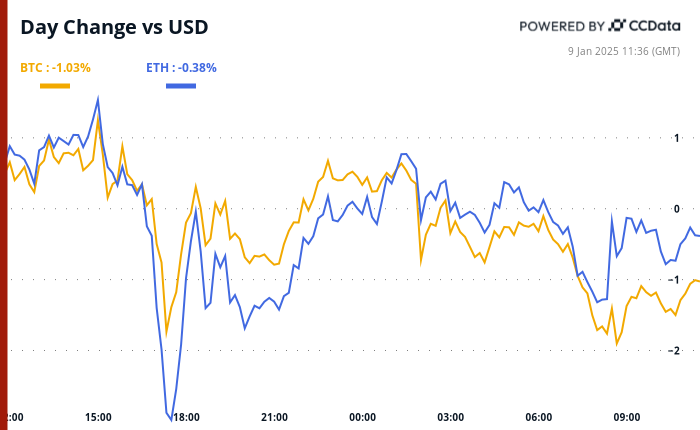
By James Van Straten (All times ET unless indicated otherwise)
The total cryptocurrency industry is now under $3.2 trillion in market capitalization, as over $300 billion has been wiped out since Jan. 6, taking away all early gains for the year, according to the TradingView metric TOTAL. As a result, bitcoin (BTC) is now hovering above $93,000 but has been making a succession of higher lows starting from Dec. 30.
Adding to the bearish sentiment, market is digesting the unconfirmed reports from DB News which suggest that the U.S. government has been given the green light to liquidate as much as 69,370 BTC ($6.5B) from the Silk Road seizure. This makes the political theatre between the outgoing and incoming U.S. administrations even more intriguing, as president-elect Donald Trump, who is just few days away from being sworn in on Jan. 20, vowed not to sell any of the bitcoin held by U.S. authorities, which, according to Glassnode data, amounts to 187,236 BTC.
The onslaught in the crypto industry stems from an extremely high DXY index, above 109, which measures the value of the U.S. Dollar relative to a weighted basket of major foreign currencies. In addition, for a brief moment, the U.S. treasury yields were rising before retreating slightly yesterday. The benchmark for 10-year yield was as high as 4.73%.
The inflation concerns that paddled the selloff in the broader market is picking up alongside growth expectations, LondonCryptoClub told CoinDesk. «The combination of rising growth and inflation expectations alongside rising term premia as the market struggles to digest huge treasury supply to fund these deficits is pushing U.S. yields higher, which is dragging global yields higher, excluding China.»
However, turmoil is occurring across the pond in the U.K., with gilt yields continuing to march higher this morning. Records were set today, as the 30-year U.K. jumped to almost 5.45%, the highest level since 1998. While the benchmark U.K. 10-year challenged 4.95%, the highest since 2008, the treasury was forced to intervene in the market to calm investors, according to reports from The Telegraph.
LondonCryptoClub mentioned the key reasons for the turmoil, «the U.K. is under pressure after a disastrous budget which has increased borrowing needs with little to no positive growth impact, exacerbating the negative debt/GDP dynamics and driving a larger fiscal deficit.»
As a result, the not-so-Great British pound, falling yet again, is now 1.22 against the dollar, the lowest level since November 2023, and has fallen almost 4% in the past month.
Today, Jan. 9, is declared a mourning day in the U.S. to remember the death of former President Jimmy Carter. Therefore, the stock market will be closed. So, all eyes will be turning to the jobs report on Friday. The market is in a good news is bad news scenario as rate cuts for 2025 get pushed back with only one rate cut expected for 2025.
A strong jobs report could remove this rate cut, with unemployment expected to come in at 4.2%, while nonfarm payroll is estimated at 154,000. A hot jobs print could send the dollar to 110, putting further pressure on risk-assets.
Stay alert!
What to Watch
Crypto
Jan. 9, 1:00 a.m.: Cronos (CRO) zkEVM mainnet upgrades to ZKsync’s latest release.
Jan. 12, 10:30 p.m.: Binance will halt Fantom token (FTM) deposits and withdrawals and delist all FTM trading pairs. FTM tokens will be swapped for S tokens at a 1:1 ratio.
Jan. 15: Derive (DRV) to create and distribute new tokens in token generation event.
Jan. 15: Mintlayer version 1.0.0 release. The mainnet upgrade introduces atomic swaps, enabling native BTC cross-chain swaps.
Jan. 16, 3:00 a.m.: Trading for the Sonic token (S) is set to start on Binance, featuring pairs like S/USDT, S/BTC, and S/BNB.
Macro
Jan. 10, 8:30 a.m.: The U.S. Bureau of Labor Statistics (BLS) releases December 2024’s Employment Situation Summary report.
Nonfarm payrolls Est. 154K vs. Prev. 227K.
Unemployment rate Est. 4.2% vs Prev. 4.2%.
Jan. 10, 10:00 a.m.: The University of Michigan releases January’s Michigan Consumer Sentiment (Preliminary). Est. 73.8 vs. Prev. 74.0.
Jan. 14, 8:30 a.m.: The U.S. Bureau of Labor Statistics (BLS) releases December 2024’s PPI data.
PPI MoM Prev. 0.4%.
Core PPI MoM Prev. 0.2%.
Core PPI YoY Prev. 3.4%.
PPI YoY Prev. 3%.
Jan. 14, 8:55 a.m.: U.S. Redbook YoY for the week ending on Jan. 11. Prev. 6.8%.
Jan. 15, 8:30 a.m.: The U.S. Bureau of Labor Statistics (BLS) releases December 2024’s Consumer Price Index Summary.
Core Inflation Rate MoM Prev. 0.3%.
Core Inflation Rate YoY Prev. 3.3%.
Inflation Rate MoM Prev. 0.3%.
Inflation Rate YoY Prev. 2.7%.
Jan. 16, 2:00 a.m.: The U.K.’s Office for National Statistics November 2024’s GDP estimate.
GDP MoM Prev. -0.1%
GDP YoY Prev. 1.3%.
Jan. 16, 8:30 a.m.: The U.S. Department of Labor releases the Unemployment Insurance Weekly Claims Report for the week ending on Jan. 11. Initial Jobless Claims Prev. 201K.
Token Events
Governance votes & calls
Gitcoin DAO started discussions on the launch of Allo.Capital, an entity focused on building tools for on-chain capital allocation.
Compound DAO is discussing the creation of a New Chains Business Unit to expand into other blockchains.
Unlocks
Jan. 11: Aptos to unlock 1.13% of its APT circulating supply, worth $98.85 million.
Jan. 12: Axie Infinity to unlock 1.45% of its circulating supply, worth $14.08 million.
Jan. 14: Arbitrum to unlock 0.93% of its circulating supply, worth $70.65 million.
Token Launches
Jan. 10: Lava Network (LAVA) to be listed on KuCoin and Bybit at 5 a.m.
Jan. 10: Bybit to delist FTM (FTM) at 5 a.m..
Conferences:
Day 4 of 14: Starknet, an Ethereum layer 2, is holding its Winter Hackathon (online).
Jan. 13-24: Swiss WEB3FEST Winter Edition 2025 (Zug, Zurich, St. Moritz, Davos)
Jan. 17: Unchained: Blockchain Business Forum 2025 (Los Angeles)
Jan. 18: BitcoinDay (Naples, Florida)
Jan. 20-24: World Economic Forum Annual Meeting (Davos-Klosters, Switzerland)
Jan. 21: Frankfurt Tokenization Conference 2025
Jan. 25-26: Catstanbul 2025 (Istanbul). The first community conference for Jupiter, a decentralized exchange (DEX) aggregator built on Solana.
Jan 30-31: Plan B Forum (San Salvador, El Salvador)
Feb. 3: Digital Assets Forum (London)
Feb. 18-20: Consensus Hong Kong
Token Talk
By Shaurya Malwa
A parody token just got its own parody.
AI Agents upstart ai16z, a platform mimicking venture fund a16z that uses AI to manage user funds, saw a mockery of its token raffle among smallcap speculators in the past day, running to a peak of $130 million market capitalization as of European morning hours.
Where ai16z tried to blend AI with investment, LLM — short for “Large Language Model” laughs at the very concept, suggesting that if AI can be anything, it can certainly be a meme with no real utility.

X users were quick to dub LLM as the «McDonald’s version of $ai16z,» mixing fast food with AI, creating a narrative where the only intelligence was in the marketing.
It has no inherent utility or technological backing; its value is purely speculative and community-driven, based on the meme’s popularity and the humor it brings to the crypto conversation.
AI Agent projects virtuals (VIRTUALS), ai16z (AI16Z) and the broader category are down more than 20% since peak on average in the past weeks amid criticism of their claimed AI models, as a CoinDesk analysis previously noted.
Derivatives Positioning
The annualized one-month basis in BTC and ETH CME futures has retreated to 6%-7%, the lowest since the election day. The positioning continues to moderate, with ETH open interest dropping to a one-month low of $2.9 billion, according to data source Amberdata.
Annualized funding rates in perpetual futures tied to large cap tokens now hover at around 5%, down significant from last month’s excessively bullish 80% to 100%. However, the OI-normalized CVD continues to signal net selling pressure in the market.
In options market, front-end skews now show bias for BTC and ETH puts, but longer duration continue to reflect a bullish bias.
Notable block trades include a large short trade in the BTC $55K put expiring on March 29. In ETH, traders shorted calls at strikes $4,800, $5,500 and $6,000.
Market Movements:
BTC is down 1.24% from 4 p.m. ET Tuesday to $93,307.05 (24hrs: -1.8%)
ETH is up 0.23% at $3,307.13 (24hrs: -1.15%)
CoinDesk 20 is down 1.18% to 3,954.73 (24hrs: -2.28%)
Ether staking yield is up 1 bp to 3.15%
BTC funding rate is at 0.0061% (6.66% annualized) on Binance
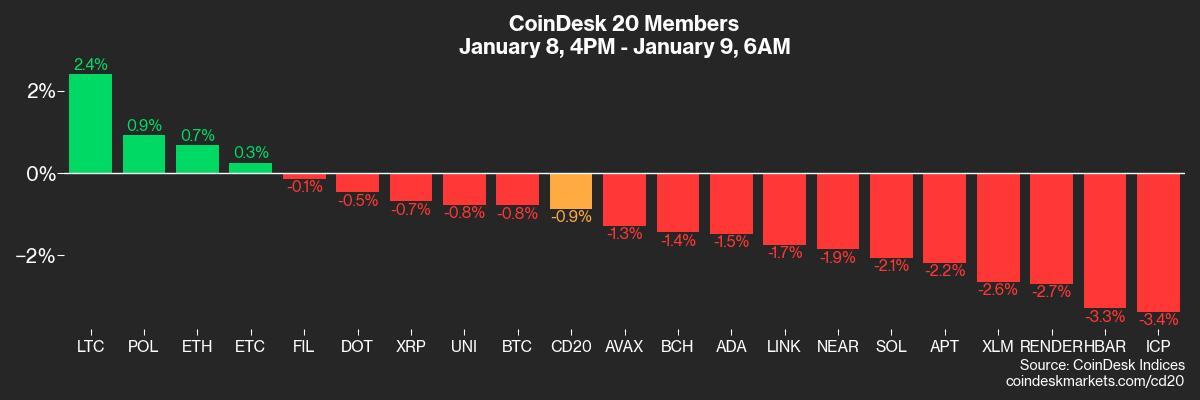
DXY is up unchanged at 109.19
Gold is up 0.72% at $2,683.8/oz
Silver is up 1.71% to $30.86/oz
Nikkei 225 closed -0.94% at 39,605.09
Hang Seng closed -0.2% at 19,240.89
FTSE is up 0.63% at 8,303.24
Euro Stoxx 50 is unchanged at 4,997.63
DJIA closed +0.25% to 42,635.20
S&P 500 closed +0.16% at 5,918.25
Nasdaq closed unchanged at 19,478.88
S&P/TSX Composite Index closed +0.49% at 25,051.70
S&P 40 Latin America closed -0.87% at 2,204.98
U.S. 10-year Treasury is down 2 bps at 4.68%
E-mini S&P 500 futures are down 0.1% to 5,953.0
E-mini Nasdaq-100 futures are down 0.18% at 21,323.00
E-mini Dow Jones Industrial Average Index futures are unchanged at 42,874.00
Bitcoin Stats:
BTC Dominance: 57.85
Ethereum to bitcoin ratio: 0.035
Hashrate (seven-day moving average): 785 EH/s
Hashprice (spot): $55.7
Total Fees: 7.57 BTC/ / $722,439
CME Futures Open Interest: 176,215 BTC
BTC priced in gold: 34.8 oz
BTC vs gold market cap: 9.90%
Basket Performance
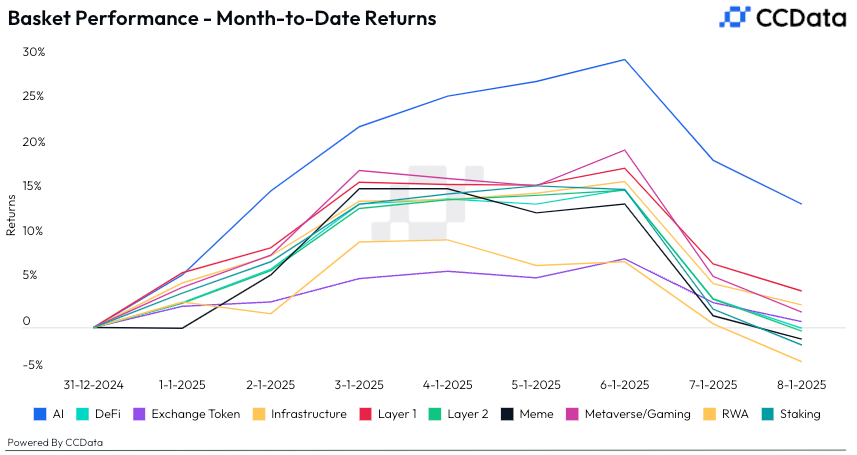
Technical Analysis
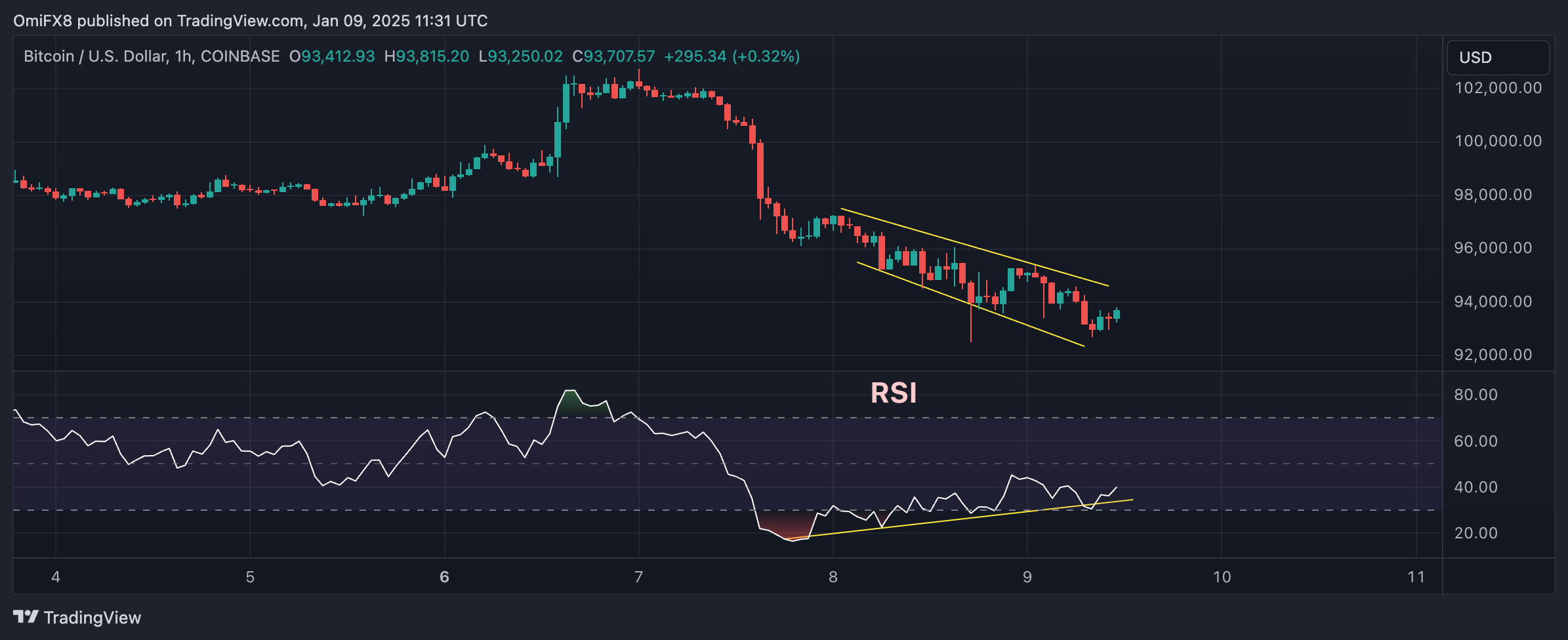
The chart shows BTC’s downward momentum is weakening.
While prices continue to chalk out lower highs, the momentum oscillator RSI is now moving in the opposite direction, diverging bullishly to signal a potential price bounce ahead.
Crypto Equities
MicroStrategy (MSTR): closed on Wednesday at $331.7 (-2.85%%), up 0.99% at $335.00 in pre-market.
Coinbase Global (COIN): closed at $260.01 (-1.63%), up 0.55% at $261.45 in pre-market.
Galaxy Digital Holdings (GLXY): closed at C$27.62 (-2.23%)
MARA Holdings (MARA): closed at $18.34 (-3.84%), up 0.11% at $18.36
in pre-market.
Riot Platforms (RIOT): closed at $12.02 (-3.14%), unchanged in pre-market.
Core Scientific (CORZ): closed at $14.05 (-0.5%), up 0.36% at $14.10 in pre-market.
CleanSpark (CLSK): closed at $10.09 (-5.79%), unchanged in pre-market.
CoinShares Valkyrie Bitcoin Miners ETF (WGMI): closed at $23.15 (-4.93%), down 1.08% at $22.90 in pre-market.
Semler Scientific (SMLR): closed at $50.19 (-9.14%), unchanged in pre-market.
Exodus Movement (EXOD): closed at $37.78 (-3.89%), up 0.21% at $37.86 in pre-market.
ETF Flows
Spot BTC ETFs:
Daily net flow: -$568.8 million
Cumulative net flows: $36.37 billion
Total BTC holdings ~ 1.140 million.
Spot ETH ETFs
Daily net flow: -$159.4 million
Cumulative net flows: $2.52 billion
Total ETH holdings ~ 3.627 million.
Source: Farside Investors, as of Jan. 8.
Overnight Flows
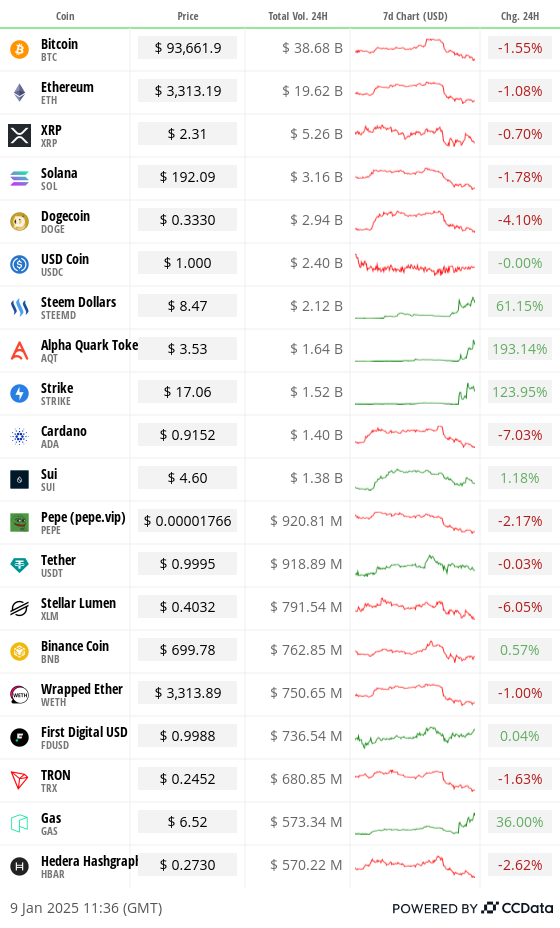
Chart of the Day
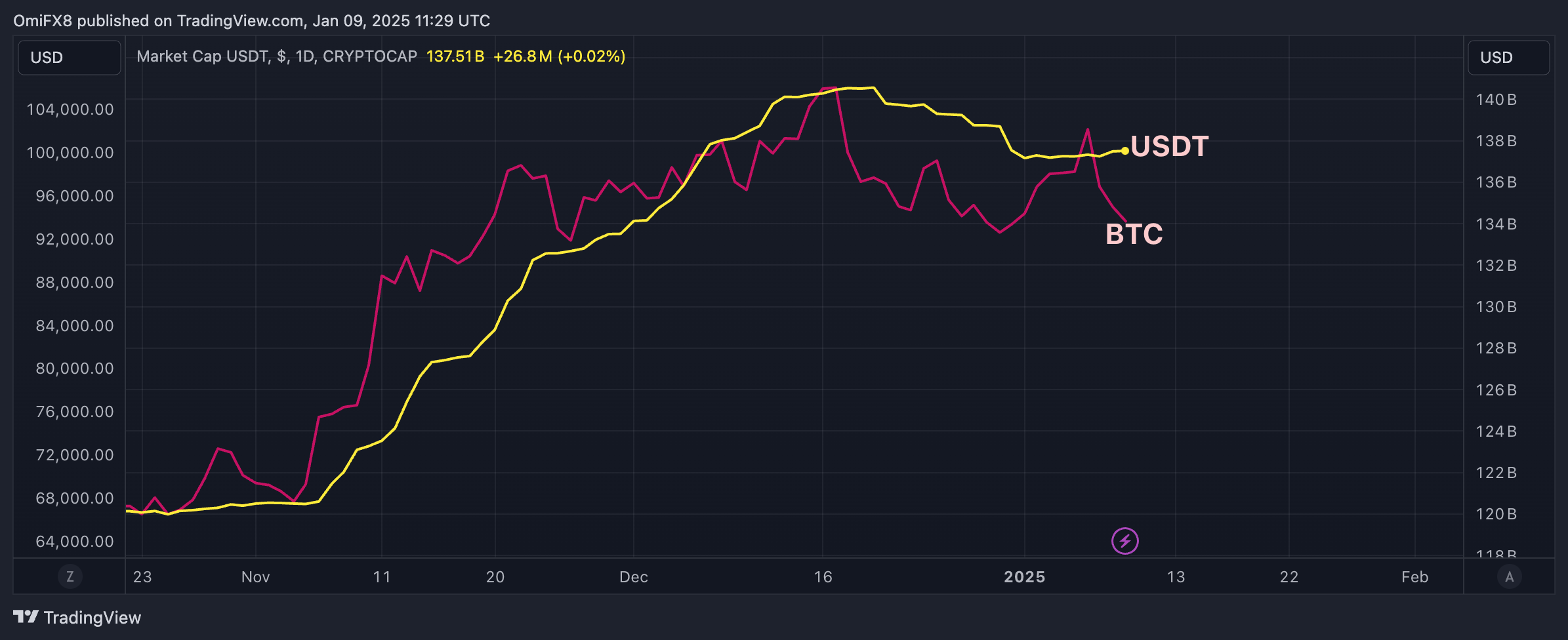
The MiCA-led decline in tether’s (USDT) market capitalization has stalled.
So, the ongoing decline in BTC may lose momentum. USDT, the world’s largest dollar-pegged cryptocurrency is widely used to fund crypto purchases.
While You Were Sleeping
Bitcoin ETFs Suffer $582M Net Outflow, Second-Highest Tally Ever (CoinDesk): Bitcoin and ether ETFs saw $582M and $159M in outflows Wednesday as the Fed’s December FOMC meeting minutes noted inflation risks from Trump’s policies and a possible slowdown in rate cuts.
XRP May Surge 40% As ‘Trump Effect’ Boosts Ripple Sentiment (CoinDesk): XRP, up 300% since November amid optimism for Trump’s crypto-friendly policies, could see another 40% surge as technical analysis highlights a bullish breakout from its descending triangle pattern.
Bitfinex Relocates Derivatives Services to El Salvador (The Block): Bitfinex Derivatives is relocating to El Salvador after obtaining its second license to operate under the nation’s crypto-friendly framework, allowing it to enhance its services and strengthen its regional presence.
Bond Market Selloff Jolts Global Investors As Trump Worries Grow (Reuters): A global bond price drop on Wednesday pushed yields to multi-year highs in the U.S., U.K., and Eurozone, driven by inflation risks, heavy bond issuance, and concerns about Trump’s tariff threats.
China Consumer Prices Weaken Further, Adding to Deflation Worries (Bloomberg): China’s inflation slowed for a fourth month in December, with CPI up just 0.1% year-on-year, the National Bureau of Statistics reported, highlighting deflation risks amid global inflation pressures.
Asia’s Central Banks Face a Formidable Challenge: An Ascendant U.S. Dollar (CNBC): The U.S. dollar’s post-election rally has devalued the currencies of Japan, China, South Korea, and India, raising import costs for these nations and complicating their central banks’ economic strategies.
In the Ether
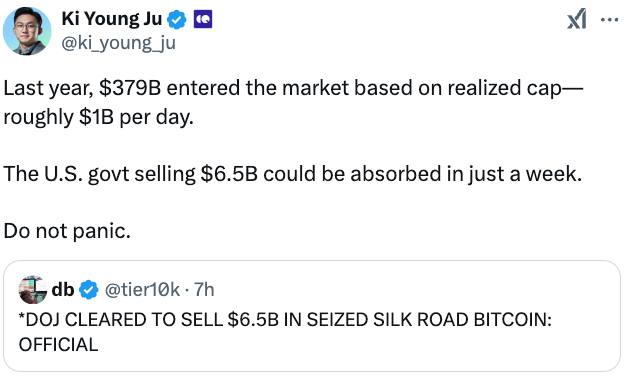
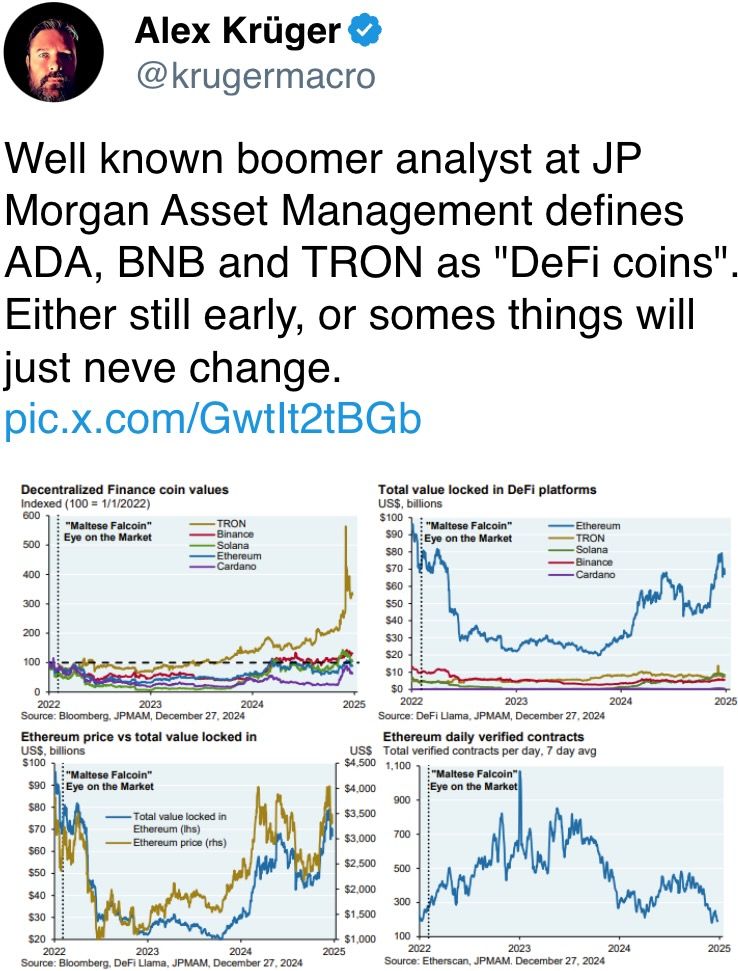

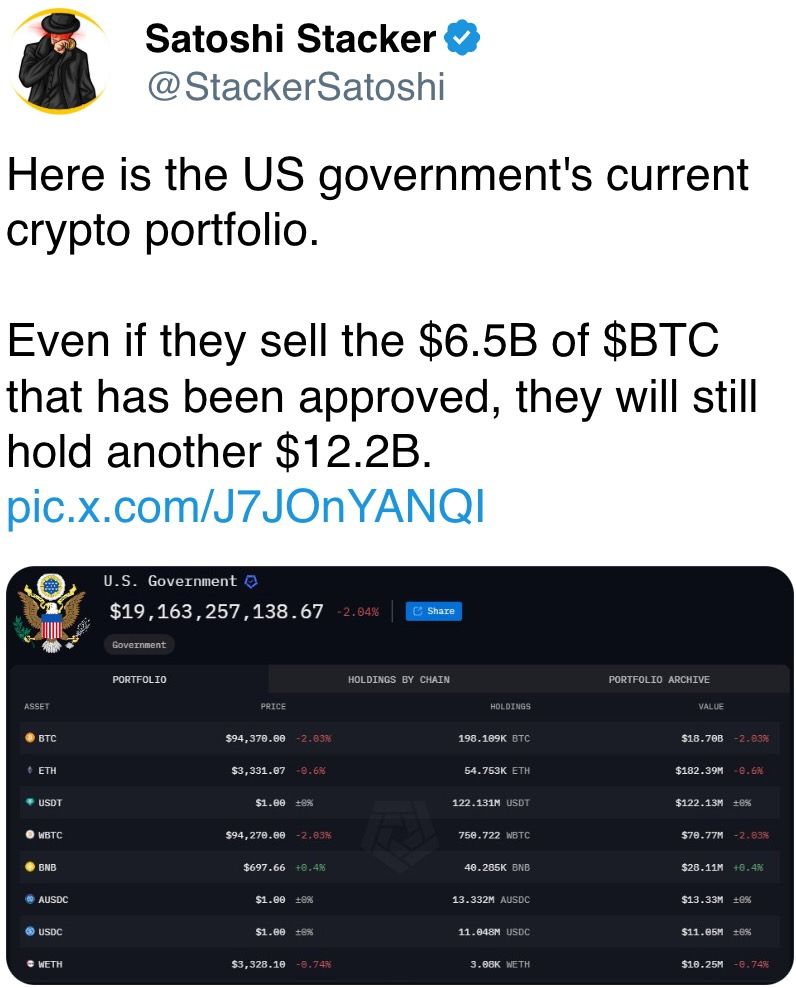

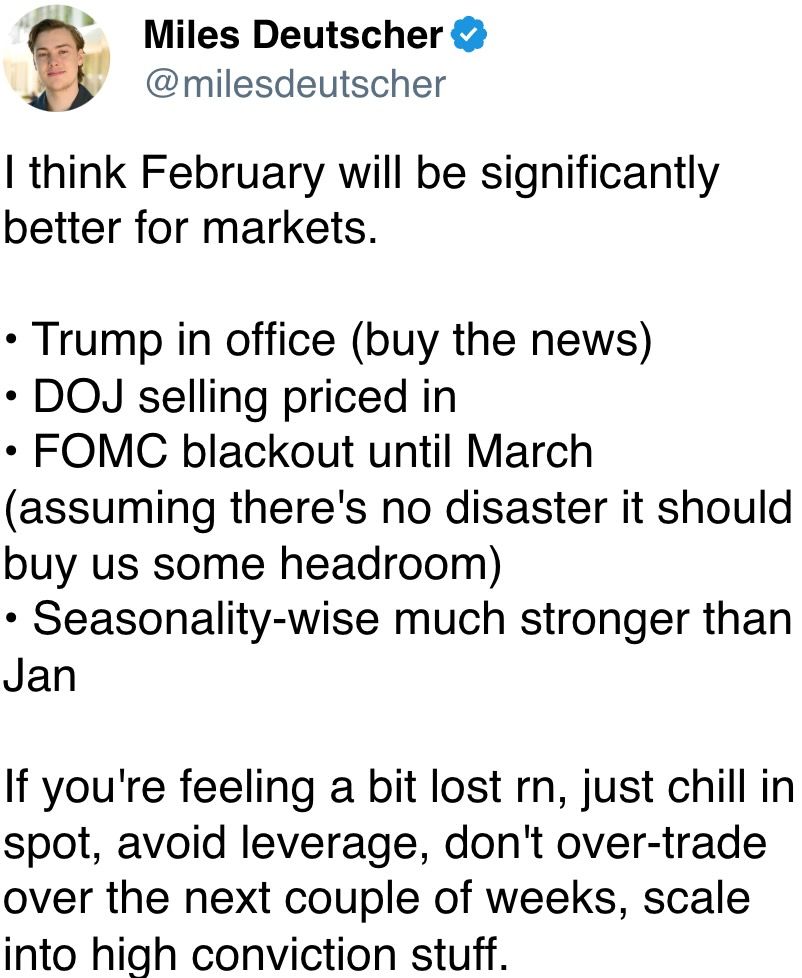
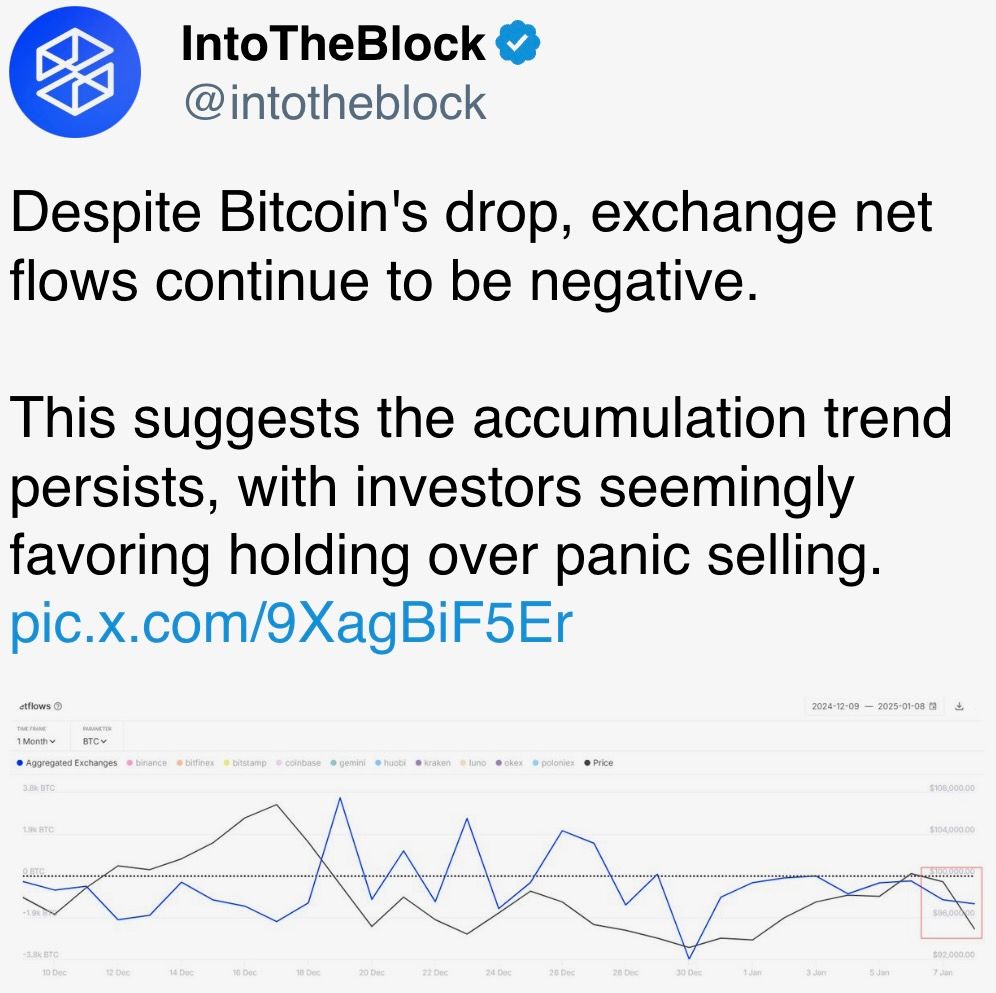
Uncategorized
AI, Mining News: GPU Gold Rush: Why Bitcoin Miners Are Powering AI’s Expansion

When Core Scientific signed a $3.5 billion deal to host artificial intelligence (AI) data centers earlier this year, it wasn’t chasing the next crypto token — it was chasing a steadier paycheck. Once known for its vast fleets of bitcoin mining rigs, the company is now part of a growing trend: converting energy-intensive mining operations into high-performance AI facilities.
Bitcoin miners like Core, Hut 8 (HUT) and TeraWulf (WULF) are swapping ASIC machines — the dedicated bitcoin mining computer — for GPU clusters, driven by the lure of AI’s explosive growth and the harsh economics of crypto mining.
Power play
It’s no secret that bitcoin mining requires an extensive amount of energy, which is the biggest cost of minting a new digital asset.
Back in the 2021 bull run, when the Bitcoin network’s hashrate and difficulty were low, miners were making out like bandits with margins as much as 90%. Then came the brutal crypto winter and the halving event, which slashed the mining reward in half. In 2025, with surging hashrate and energy prices, miners are now struggling to survive with razor-thin margins.
However, the need for power—the biggest input cost—became a blessing in disguise for these miners, who needed a different strategy to diversify their revenue sources.
Due to rising competition for mining, the miners continued to procure more machines to stay afloat, and with it came the need for more megawatts of electricity at a cheaper price. Miners invested heavily in securing these low-cost energy sources, such as hydroelectric or stranded natural gas sites, and developed expertise in managing high-density cooling and electrical systems—skills honed during the crypto boom of the early 2020s.
This is what captured the attention of AI and cloud computing firms. While bitcoin relies on specialized ASICs, AI thrives on versatile GPUs like Nvidia’s H100 series, which require similar high-power environments but for parallel processing tasks in machine learning. Instead of building out data centers from scratch, taking over mining infrastructure, which already has power ready, became a faster way to grow an increasing appetite for AI-related infrastructure.
Essentially, these miners aren’t just pivoting—they’re retrofitting.
The cooling systems, low-cost energy contracts, and power-dense infrastructure they built during the crypto boom now serve a new purpose: feeding the AI models of companies like OpenAI and Google.
Firms like Crusoe Energy sold off mining assets to focus solely on AI, deploying GPU clusters in remote, energy-rich locations that mirror the decentralized ethos of crypto but now fuel centralized AI hyperscalers.
Terraforming AI
Bitcoin mining has effectively «terraformed» the terrain for AI compute by building out scalable, power-efficient infrastructure that AI desperately needs.
As Nicholas Gregory, Board Director at Fragrant Prosperity, noted, «It can be argued bitcoin paved the way for digital dollar payments as can be seen with USDT/Tether. It also looks like bitcoin terraformed data centres for AI/GPU compute.»
This pre-existing «terraforming» allows miners to retrofit facilities quickly, often in under a year, compared to the multi-year timelines for traditional data center builds. Firms like Crusoe Energy sold off mining assets to focus solely on AI, deploying GPU clusters in remote, energy-rich locations that mirror the decentralized ethos of crypto but now fuel centralized AI hyperscalers.
Higher returns
In practice, it means miners can flip a facility in less than a year—far faster than the multi-year timeline of a new data center.
But AI isn’t a cheap upgrade.
Bitcoin mining setups are relatively modest, with costs ranging from $300,000 to $800,000 per megawatt (MW) excluding ASICs, allowing for quick scalability in response to market cycles. Meanwhile, AI infrastructure demands significantly higher capex due to the need for advanced liquid cooling, redundant power systems, and the GPUs themselves, which can cost tens of thousands per unit and face global supply shortages. Despite the steeper upfront costs, AI offers miners up to 25 times more revenue per kilowatt-hour than bitcoin mining, making the pivot economically compelling amid rising energy prices and declining crypto profitability.
A niche industry worth billions
As AI continues to surge and crypto profits tighten, bitcoin mining could become a niche game—one reserved for energy-rich regions or highly efficient players, especially as the next in 2028 could render many operations unprofitable without breakthroughs in efficiency or energy costs.
While projections show the global crypto mining market growing to $3.3 billion by 2030, at a modest 6.9% CAGR, the billions would be overshadowed by AI’s exponential expansion. According to KBV Research, the global AI in mining market is projected to reach $435.94 billion by 2032, expanding at a compound annual growth rate (CAGR) of 40.6%.
With investors already seeing dollar signs in this shift, the broader trend suggests the future is either a hybrid or a full conversion to AI, where stable contracts with hyperscalers promise longevity over crypto’s boom-bust cycles.
This evolution not only repurposes idle assets but also underscores how yesterday’s crypto frontiers are forging tomorrow’s AI empires.
Uncategorized
Bitcoin Climbs as Economy Cracks — Is it Bullish or Bearish?

Bitcoin (BTC) is about 4% higher than it was a week ago—good news for the digital asset but bad news for the economy.
The recent negative tone of the economic data points from last week raised expectations that the Federal Reserve will cut interest rates on Wednesday, making riskier assets such as stocks and bitcoin more attractive.
Let’s recap the data that backs up that thesis.
The most important one, the U.S. CPI figures, came out on Thursday. The headline rate was slightly higher than expected, a sign inflation might be stickier than anticipated.
Before that, we had Tuesday’s revisions to job data. The world’s largest economy created almost 1 million fewer jobs than reported in the year ended March, the largest downward revision in the country’s history.
The figures followed the much-watched monthly jobs report, which was released the previous Friday. The U.S. added just 22,000 jobs in August, with unemployment rising to 4.3%, the Bureau of Labor Statistics said. Initial jobless claims rose 27,000 to 263,000 — the highest since October 2021.
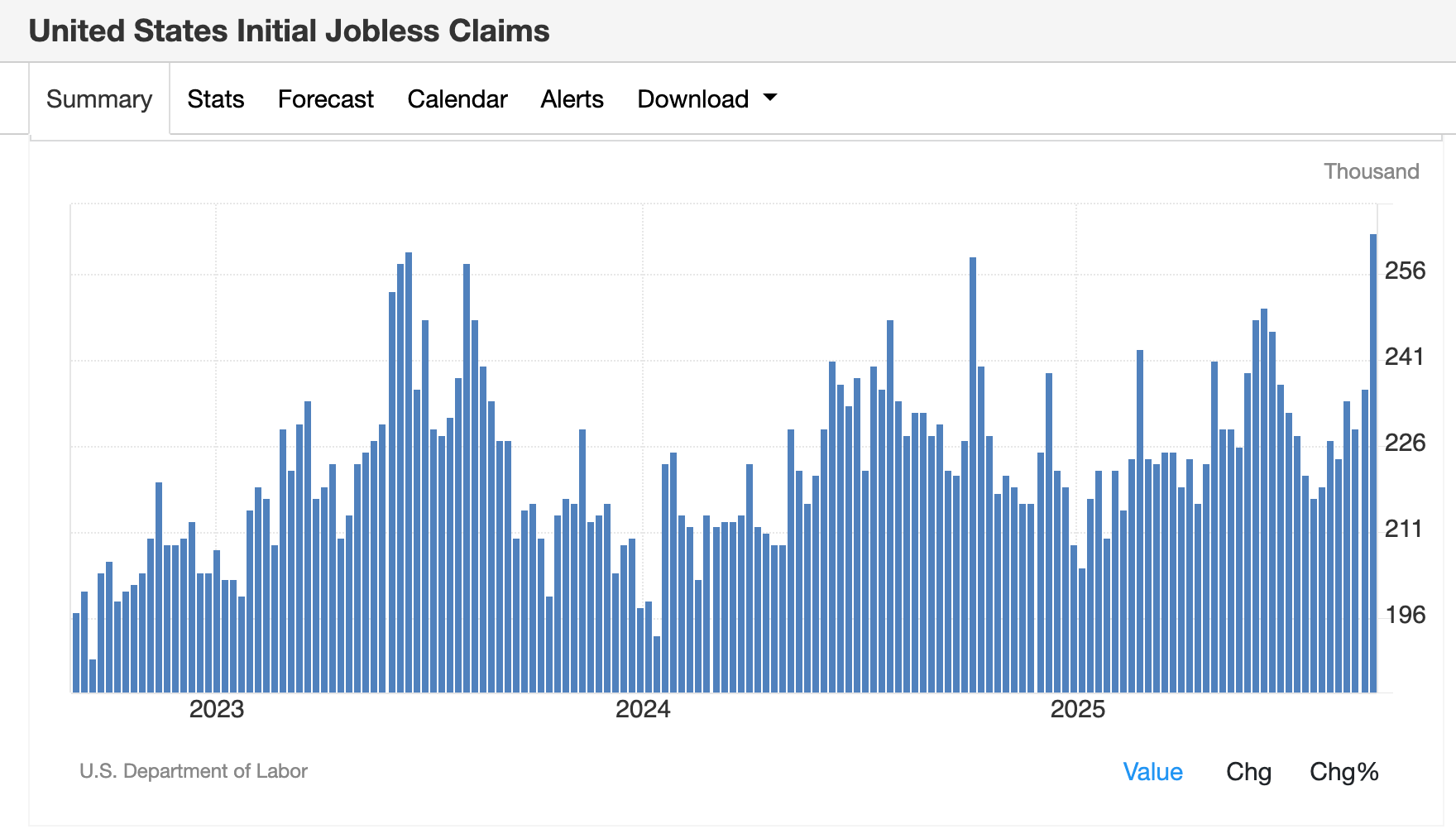
Higher inflation and fewer jobs are not great for the U.S. economy, so it’s no surprise that the word «stagflation» is starting to creep back into macroeconomic commentary.
Against this backdrop, bitcoin—considered a risk asset by Wall Street—continued grinding higher, topping $116,000 on Friday and almost closing the CME futures gap at 117,300 from August.
Not a surprise, as traders are also bidding up the biggest risk assets: equities. Just take a look at the S&P 500 index, which closed at a record for the second day on the hope of a rate cut.
So how should traders think about BTC’s price chart?
To this chart enthusiast, price action remains constructive, with higher lows forming from the September bottom of $107,500. The 200-day moving average has climbed to $102,083, while the Short-Term Holder Realized Price — often used as support in bull markets — rose to a record $109,668.
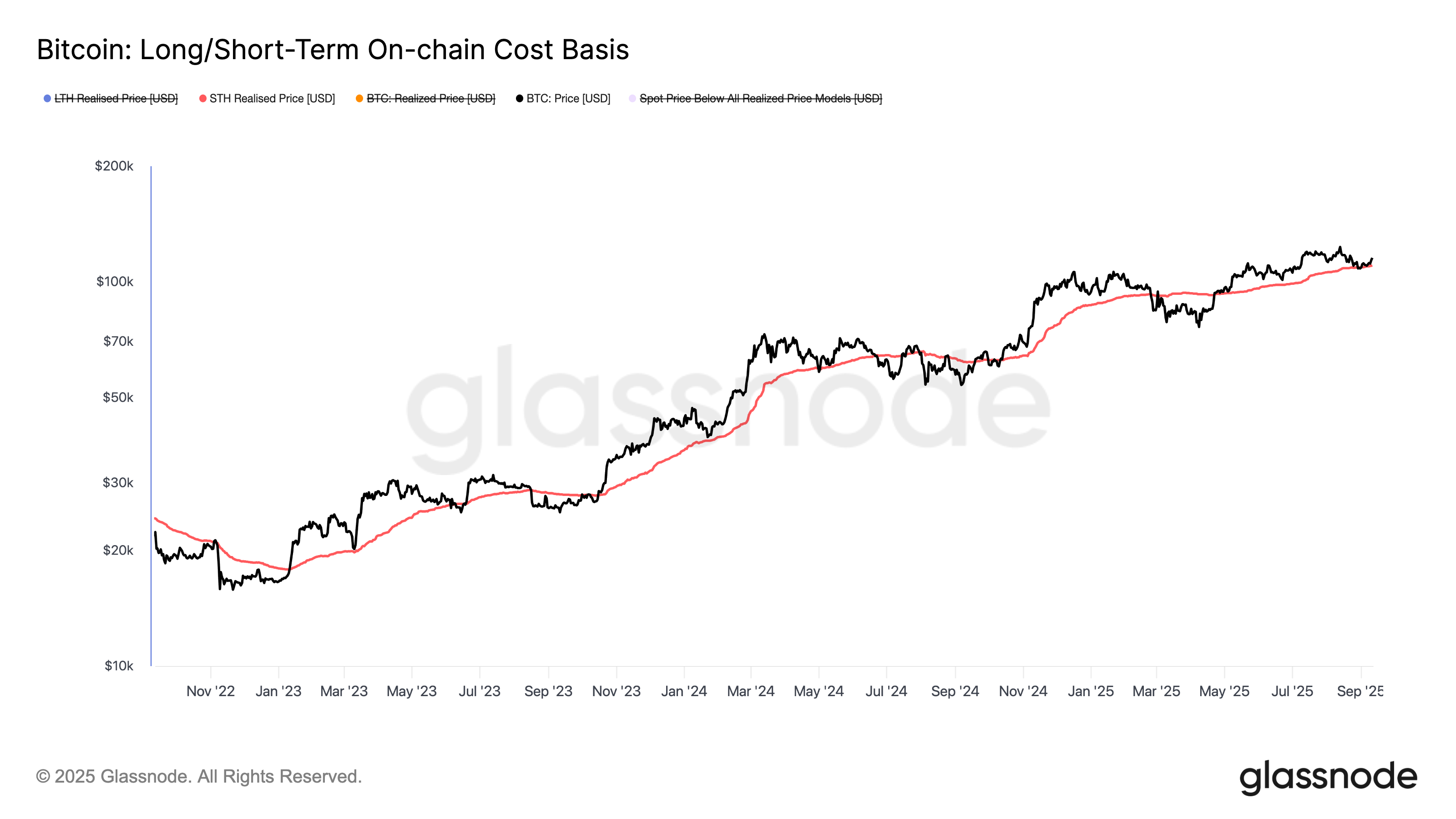
Bitcoin-linked stocks: A mixed bag
However, bitcoin’s weekly positive price action didn’t help Strategy (MSTR), the largest of the bitcoin treasury companies, whose shares were about flat for the week. Its rivals performed better: MARA Holdings (MARA) 7% and XXI (CEP) 4%.
Strategy (MSTR) has underperformed bitcoin year-to-date and continues to hover below its 200-day moving average, currently $355. At Thursday’s close of $326, it’s testing a key long-term support level seen back in September 2024 and April 2025.
The company’s mNAV premium has compressed to below 1.5x when accounting for outstanding convertible debt and preferred stock, or roughly 1.3x based solely on equity value.
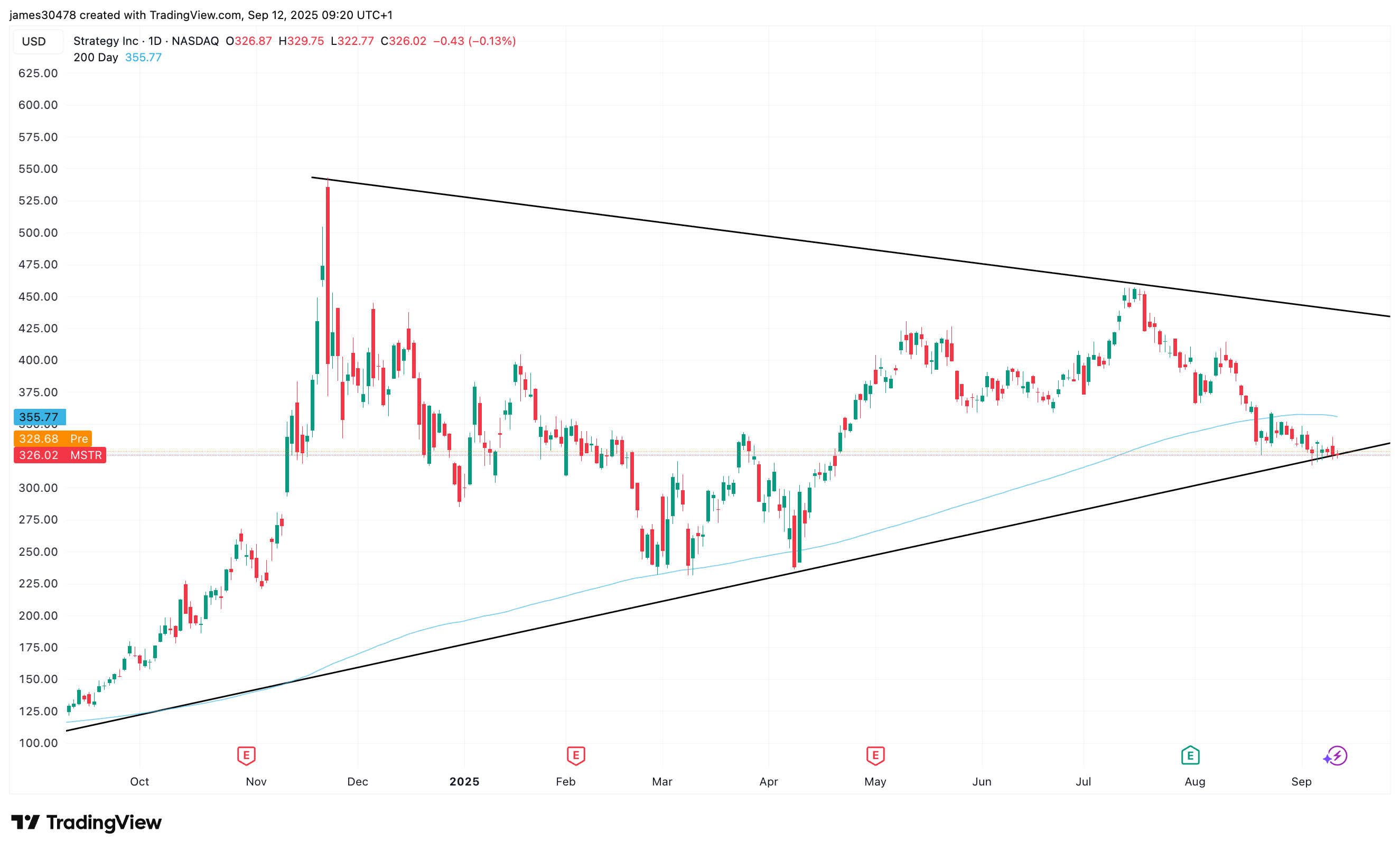
Preferred stock issuance remains muted, with only $17 million tapped across STRK and STRF this week, meaning that the bulk of at-the-money issuance is still flowing through common shares. According to the company, options are now listed and trading for all four perpetual preferred stocks, a development that could provide additional yield on the dividend.
Bullish catalysts for crypto stocks?
The CME’s FedWatch tool shows traders expect a 25 basis-point U.S. interest-rate cut in September and have priced in a total of three rate cuts by year-end.
That’s a sign risk sentiment could tilt back toward growth and crypto-linked equities, underlined by the 10-year U.S. Treasury briefly breaking below 4% this week.
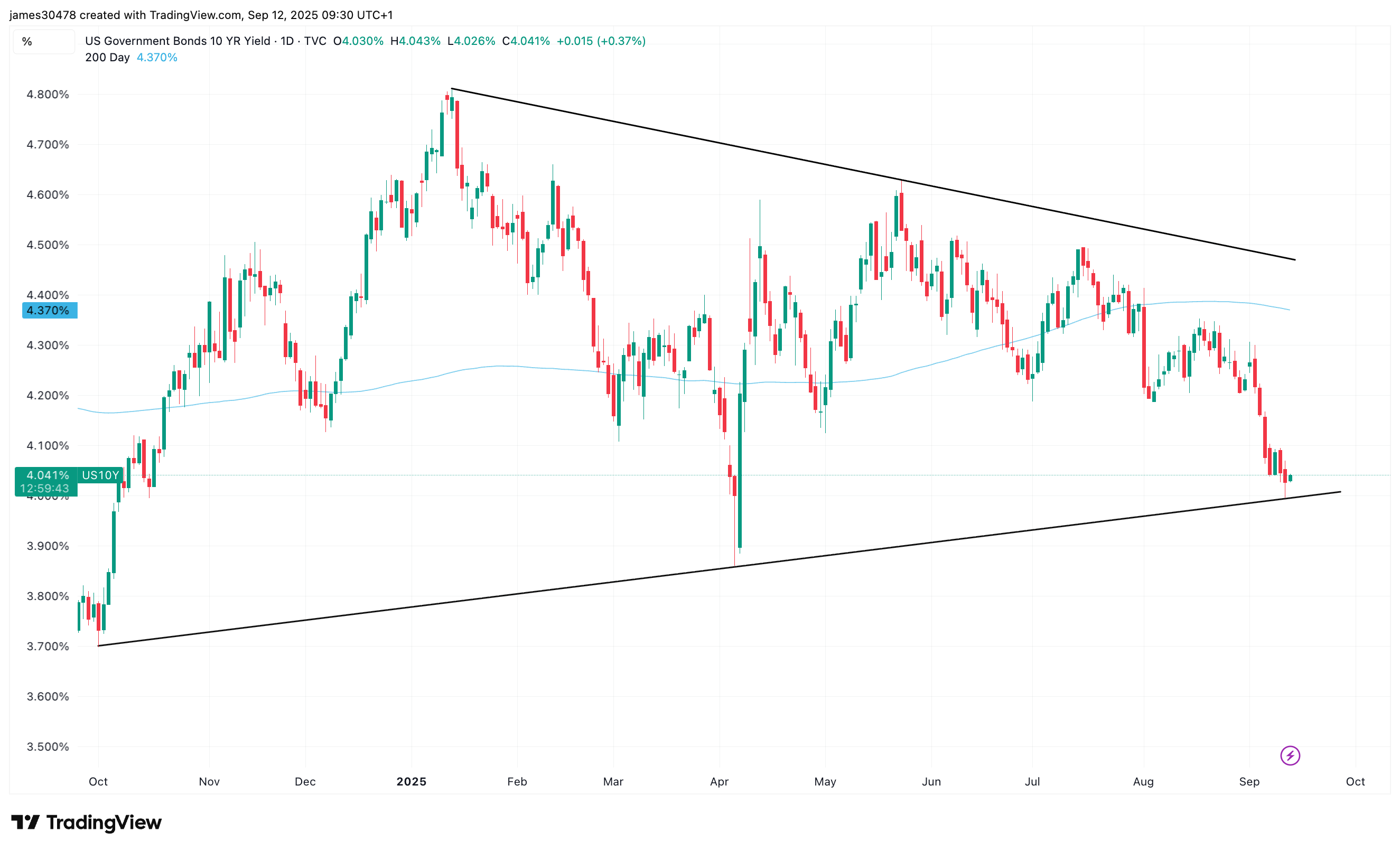
Still, the dollar index (DXY) continues to hold multiyear support, a potential inflection point worth watching.
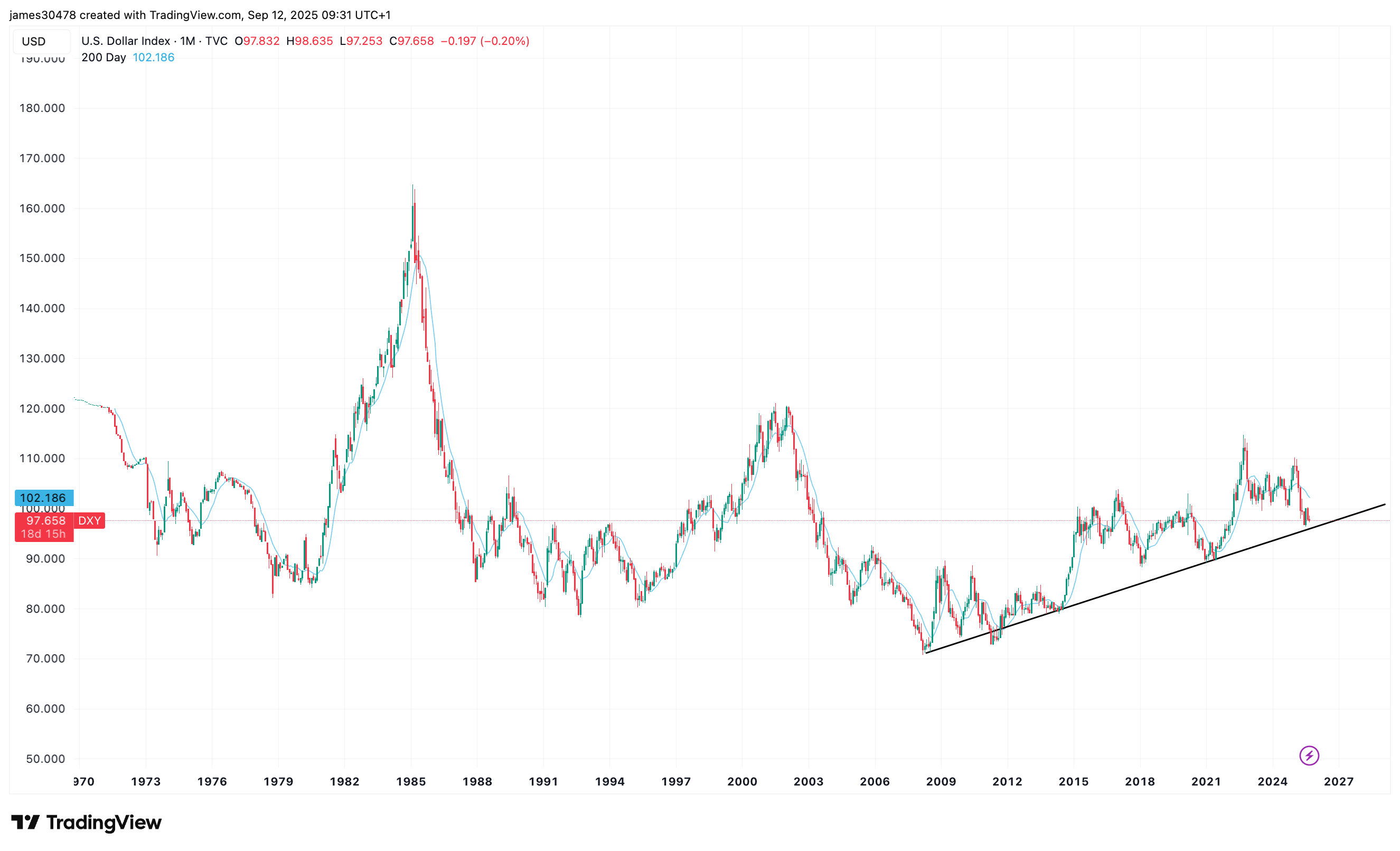
Uncategorized
Fed’s Sept. 17 Rate Cut Could Spark Short-Term Jitters but Supercharge Bitcoin, Gold and Stocks Long Term

Investors are counting down to the Federal Reserve’s Sept. 17 meeting, where markets expect a quarter-point rate cut that could trigger short-term volatility but potentially fuel longer-term gains across risk assets.
The economic backdrop highlights the Fed’s delicate balancing act.
According to the latest CPI report released by the U.S. Bureau of Labor Statistics on Thursday, consumer prices rose 0.4% in August, lifting the annual CPI rate to 2.9% from 2.7% in July, as shelter, food, and gasoline pushed costs higher. Core CPI also climbed 0.3%, extending its steady pace of recent months.
Producer prices told a similar story: per the latest PPI report released on Wednesday, the headline PPI index slipped 0.1% in August but remained 2.6% higher than a year earlier, while core PPI advanced 2.8%, the largest yearly increase since March. Together, the reports underscore stubborn inflationary pressure even as growth slows.
The labor market has softened further.
Nonfarm payrolls increased by just 22,000 in August, with federal government and energy sector job losses offsetting modest gains in health care. Unemployment held at 4.3%, while labor force participation remained stuck at 62.3%.
Revisions showed June and July job growth was weaker than initially reported, reinforcing signs of cooling momentum. Average hourly earnings still rose 3.7% year over year, keeping wage pressures alive.
Bond markets have adjusted accordingly. The 2-year Treasury yield sits at 3.56%, while the 10-year is at 4.07%, leaving the curve modestly inverted. Futures traders see a 93% chance of a 25 basis point cut, according to CME FedWatch.
If the Fed limits its move to just 25 bps, investors may react with a “buy the rumor, sell the news” response, since markets have already priced in relief.
Equities are testing record levels.
Equities are testing record levels. The S&P 500 closed Friday at 6,584 after rising 1.6% for the week, its best since early August. The index’s one-month chart shows a strong rebound from its late-August pullback, underscoring bullish sentiment heading into Fed week.
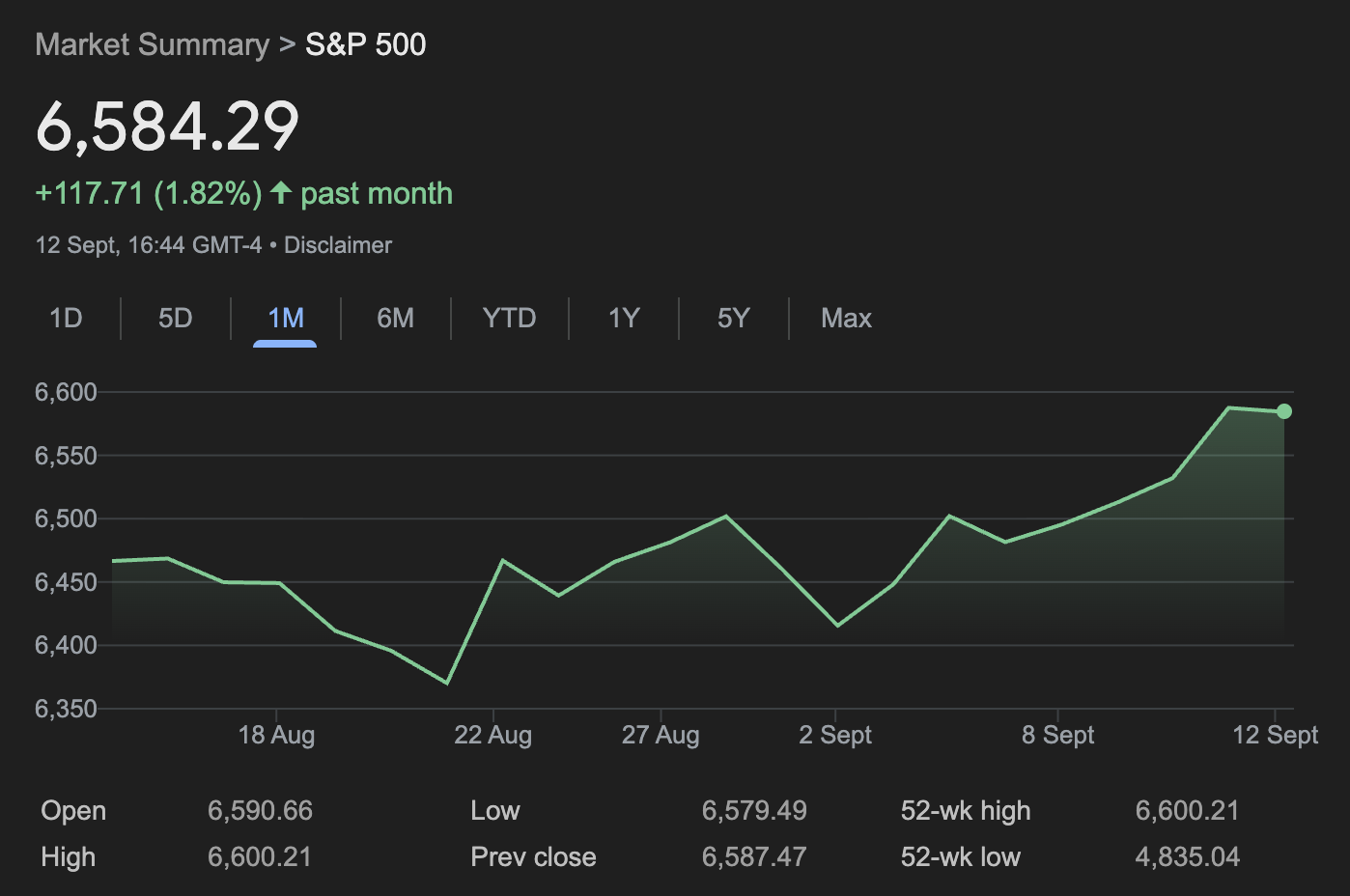
The Nasdaq Composite also notched five straight record highs, ending at 22,141, powered by gains in megacap tech stocks, while the Dow slipped below 46,000 but still booked a weekly advance.
Crypto and commodities have rallied alongside.
Bitcoin is trading at $115,234, below its Aug. 14 all-time high near $124,000 but still firmly higher in 2025, with the global crypto market cap now $4.14 trillion.
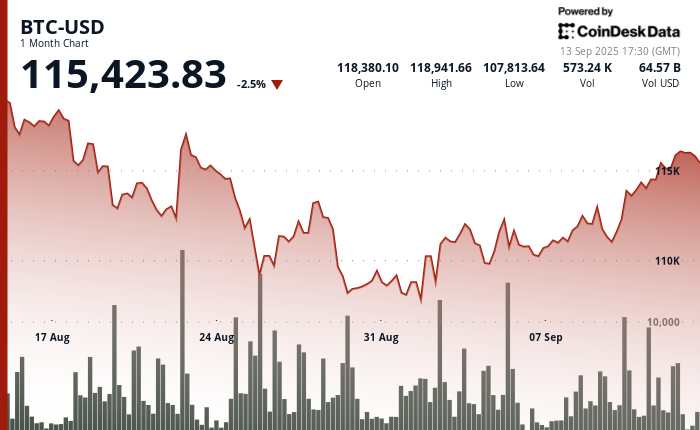
Gold has surged to $3,643 per ounce, near record highs, with its one-month chart showing a steady upward trajectory as investors price in lower real yields and seek inflation hedges.
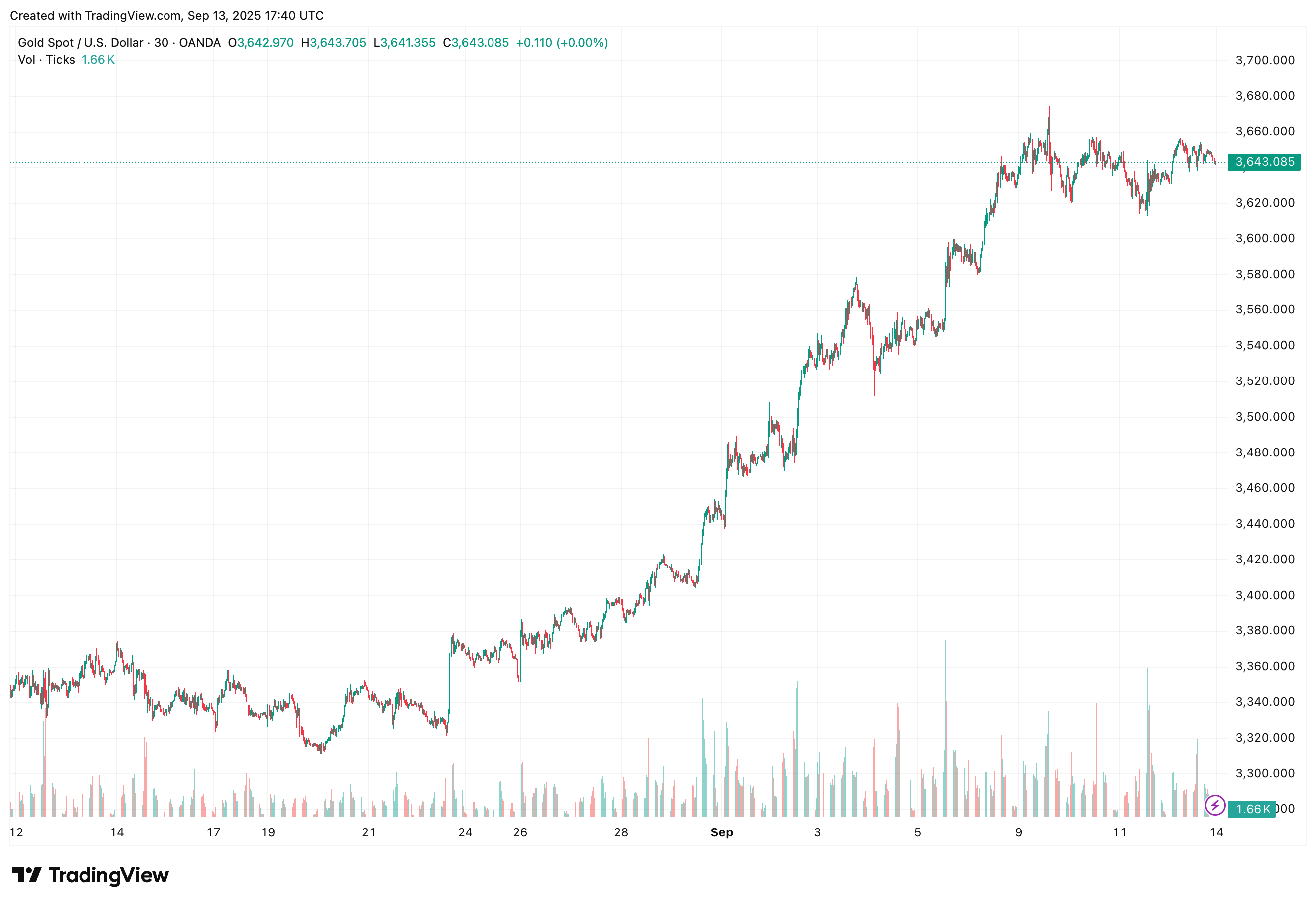
Gold has climbed steadily toward record highs, while bitcoin has consolidated below its August peak, reflecting ongoing demand for alternative stores of value.
Historical precedent supports the cautious optimism.
Analysis from the Kobeissi Letter — reported in an X thread posted Saturday — citing Carson Research, shows that in 20 of 20 prior cases since 1980 where the Fed cut rates within 2% of S&P 500 all-time highs, the index was higher one year later, averaging gains of nearly 14%.
The shorter term is less predictable: in 11 of those 22 instances, stocks fell in the month following the cut. Kobeissi argues this time could follow a similar pattern — initial turbulence followed by longer-term gains as rate relief amplifies the momentum behind assets like equities, bitcoin, and gold.
The broader setup explains why traders are watching the Sept. 17 announcement closely.
Cutting rates while inflation edges higher and stocks hover at records risks denting credibility, yet staying on hold could spook markets that have already priced in easing. Either way, the Fed’s message on growth, inflation, and its policy outlook will likely shape the trajectory of markets for months to come.
-

 Business11 месяцев ago
Business11 месяцев ago3 Ways to make your business presentation more relatable
-

 Fashion11 месяцев ago
Fashion11 месяцев agoAccording to Dior Couture, this taboo fashion accessory is back
-

 Entertainment11 месяцев ago
Entertainment11 месяцев ago10 Artists who retired from music and made a comeback
-

 Entertainment11 месяцев ago
Entertainment11 месяцев ago\’Better Call Saul\’ has been renewed for a fourth season
-

 Entertainment11 месяцев ago
Entertainment11 месяцев agoNew Season 8 Walking Dead trailer flashes forward in time
-

 Business11 месяцев ago
Business11 месяцев ago15 Habits that could be hurting your business relationships
-

 Entertainment11 месяцев ago
Entertainment11 месяцев agoMeet Superman\’s grandfather in new trailer for Krypton
-

 Entertainment11 месяцев ago
Entertainment11 месяцев agoDisney\’s live-action Aladdin finally finds its stars





